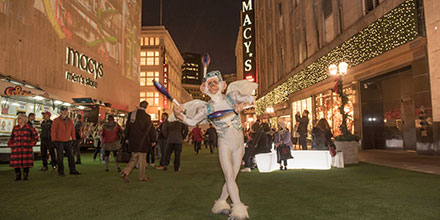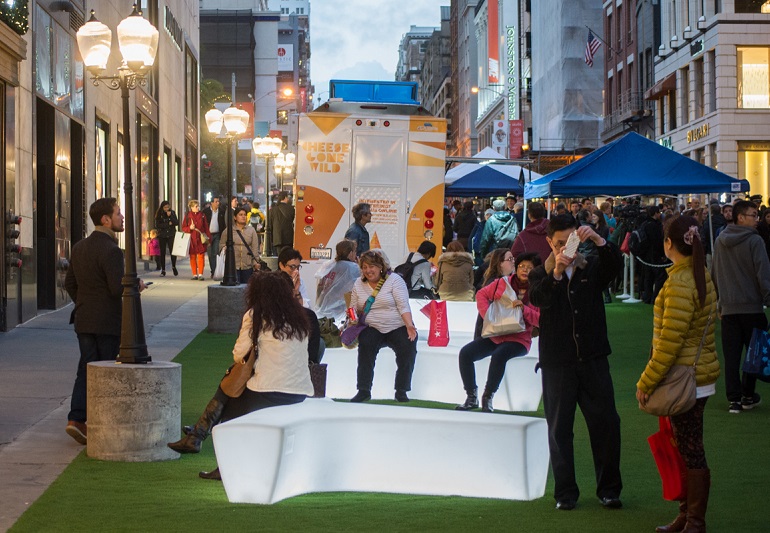This afternoon, at the San Francisco Bay Area Planning and Urban Research Association (SPUR), a panel of public officials spoke about how San Francisco's different departments are collaborating to create more livable spaces under the new "Places for People" ordinance, passed last year. "Streets represent 35 percent of the city’s total area," explained Robin Abad Ocubillo, a panelist from SF's Planning Department. That, he added, is why city agencies and lawmakers started looking for faster ways to convert streets and unused lots into public spaces.
That lead to the "Pavement to Parks" program. Created in 2009, it was launched with the creation of Jane Warner Plaza at the corner of Castro and Market. That began as a temporary installation involving paint and some movable furniture, and eventually became a permanent plaza with planters, lights, and tables and chairs. But over time it became clear the permit process made it too difficult for communities to create similar plazas and hold street events. "If you’re a community group that wants to have live music, or even a poetry reading, you need a permit for every loudspeaker that you have," explained Ocubillo. "So we wanted to mint a new permit process."
This was good news for livable streets advocates, who have long bristled at the costs and complexities of getting permits for public events. Former Supervisor Scott Wiener's "Places for People Ordinance," which passed unanimously last year, gave the legal directive to start streamlining the process. From Wiener's blog: "Under the existing law, creating Parklets has required ad hoc coordination between members of the public who wish to build these spaces, Public Works, the Planning Department, the Municipal Transportation Agency, and the Entertainment Commission. This lead to a complicated process for the public, and [to] gaps in oversight for existing spaces. The Places for People legislation will support activation of these public spaces, solidify the public process to create them, improve inter-agency coordination, and create equity by ensuring that applications come from all over the City."
Now that the enabling legislation has passed, the hard work is underway to re-organize the permit process with help from SFMTA, Planning, Public Works and other agencies and nonprofits.
Meanwhile, Ilaria Salvadori, also with the San Francisco Planning Department, talked about her work with “Ground Play,” an umbrella organization that helps get different city departments working with arts groups and advocates, such as Walk SF and the San Francisco Bicycle Coalition, to help create more tactical urban installations. "We work on . . . creating temporary changes in the public right of way intended to improve local neighborhoods and city gathering places," she said. She talked about the Market Street Prototyping Festival. "We had over fifty designers participating," she said, adding that some of the temporary projects become permanent.
Salvadori talked about her group's work on parklets. "We've helped install 65. Samovar Parklet is the latest one... it will be delivered in the Summer of 2017," she said. "I like them because they blend into the street. They become part of our landscape." But this brought up a contentious issue, which came up in an audience question. If a business is sponsoring a parklet in front of its tea shop (as in the case of the Samovar Parklet) is it really a public place anymore? But Salvadori said they make sure the furniture and installations aren't set up like a restaurant, to assure it remains a public space.
Last, Jane Wang, an SFMTA Central Subway design engineer, spoke about the Winter Walk festival, an annual event set up on Stockton Street over the Central Subway construction site. During the holidays, construction on the Central Subway ceases for six weeks. "It was conceived as a construction mitigation," she said. Machinery is removed and the space is smoothed and covered in AstroTurf. "There's caroling, a beer garden, food trucks and other offerings" during the hiatus, she explained.

This annual installation had some in the audience asking if a pedestrian-friendly Stockton Street could one day become a permanent installation as well, with only delivery trucks--but no through traffic or private cars--permitted in the area.
The presentation was a good update for 2017 about what different agencies are doing to take back some of that 35 percent of space currently dedicated to cars and return it to community use. With better permitting and bureaucratic streamlining, all the panelists were hopeful about expanding their efforts. "We work on sidewalks, curbsides, streets, and lots," said Salvadori. "Changes in the public right-of-way improve local neighborhoods and city gathering places."
For more events like these, visit SPUR’s events page.





